Last updated on January 31st, 2025
Featured image: There are so many immersive and eco-friendly things to do in Martinique | Photo by Martinique Tourism, copyright © Comité Martiniquais du Tourisme, www.martiniquetourisme.com
From gardens to birdwatching, Martinique has adventures for the active woman
by Jennifer Reynolds
Nestled in the Lesser Antilles, Martinique is a French overseas region that combines European sophistication with Caribbean vibrancy. It’s a place where history runs deep, from the legacy of colonial sugar plantations to the enduring influence of Creole culture. The island’s unique position as a bridge between cultures is reflected in its language, cuisine, and way of life — a rich tapestry woven from centuries of global interaction.
The Caribbean island is an overseas department of France and boasts a rich and complex history shaped by Indigenous cultures, colonial encounters, and the impact of slavery, making it a testament to resilience and cultural fusion. From its Indigenous roots and colonial exploitation to the abolition of slavery and modern-day efforts to preserve its rich heritage, the people of Martinique strive to honour their ancestors and ensure their stories are remembered and respected. Through museums, memorials, cultural celebrations, and ongoing education, the legacy of those who came before is kept alive, enriching the island’s present and future.
10 things for women to experience in Martinique
Martinique’s diverse landscapes provide an array of eco-friendly activities, from hiking in lush rainforests to birdwatching in serene nature reserves to kayaking in a glass-bottom boat over coral reefs.
1. Embrace Martinique’s Natural Beauty
Jardin de Balata is a botanical paradise showcasing an incredible variety of tropical flora. Wander through lush pathways enveloped by towering palms, vibrant exotic flowers, and serene ponds. This garden, a testament to the importance of preserving Martinique’s natural heritage, offers a tranquil escape into the heart of the island’s biodiversity.
Founded in the 1980s by passionate horticulturist and poet Jean-Philippe Thoze, Jardin de Balata features themed gardens, approximately 3,000 varieties of tropical plants, an elevated walkway, and breathtaking views of the surrounding area. As you explore, you’ll discover the intricate beauty and diversity of Martinique’s plant life, making Jardin de Balata a must-visit for nature lovers and serenity seekers alike. Get tickets here!
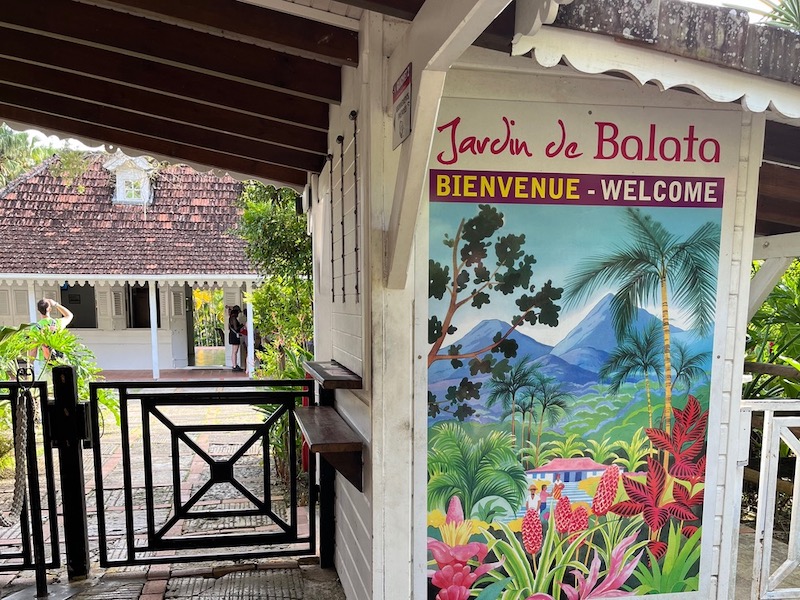
Entering the lush Jardin de Balata / Photo by Jennifer Reynolds
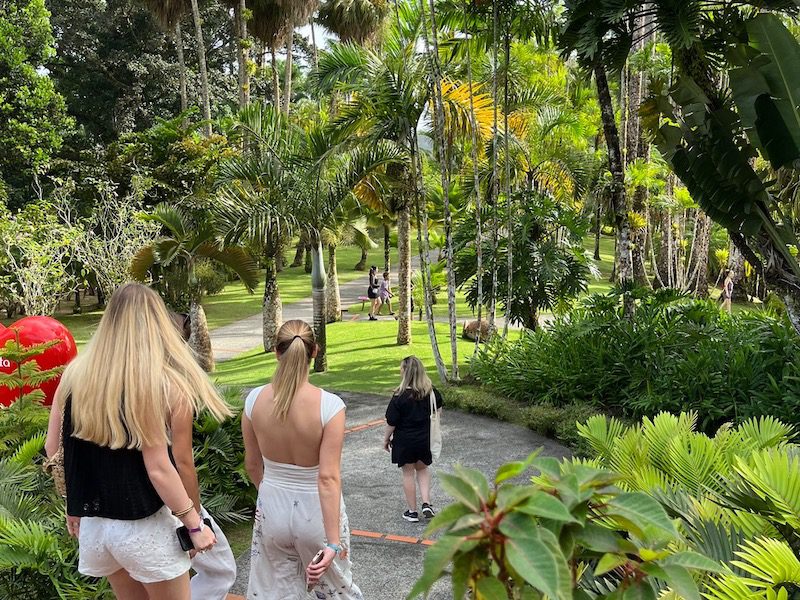
2. Enjoy Martinique’s Beaches and Marine Life
Martinique’s pristine beaches and crystal-clear waters are perfect for eco-friendly activities where you can explore vibrant marine ecosystems through snorkelling and diving adventures, participate in sea turtle conservation efforts and discover coral reefs teeming with life.
My half-day adventure with Fleurdo Éco-Excursion in Martinique was an unforgettable experience, immersing me in the island’s stunning natural beauty and rich biodiversity. Paddling through the crystal-clear waters in a two-person glass-bottom kayak, I felt like I was gliding over a living aquarium. The transparent kayak allowed us to observe the vibrant coral reefs and diverse marine life below without disturbing the delicate ecosystem. Our guide, Marc, a passionate environmentalist, shared fascinating insights about the Vauclin coastline’s mangroves, seagrass beds, and the unique interplay of the blue and green hues of the ocean and mangrove forest.
We anchored our kayaks on a secluded sandbar in the middle of the ocean, where we took a break to soak in the tranquillity of the surrounding turquoise waters. As we relaxed on the sandbar, Marc surprised us with the most delicious canapés, freshly prepared right on the boat. It was a surreal moment — sitting in the middle of the ocean, savouring gourmet food, and feeling completely at one with nature in this pristine ecosystem.
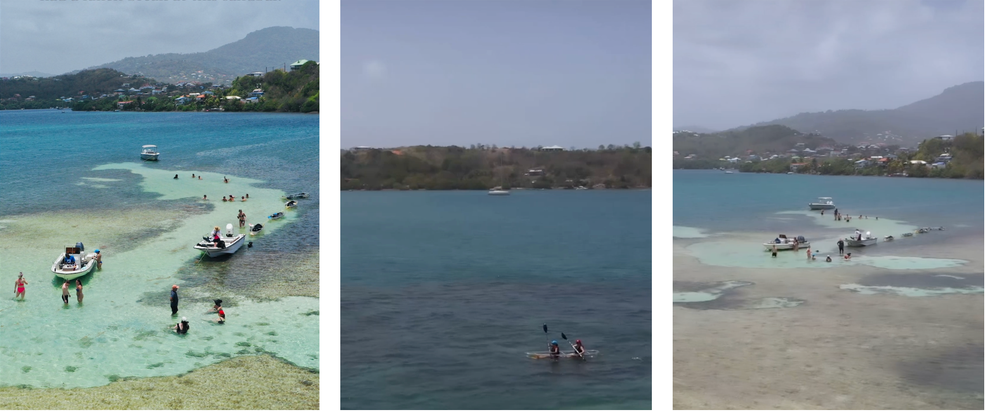
The island’s commitment to marine preservation ensures that coral reefs remain healthy for future generations / Photo by Jennifer Reynolds
3. Savour Martinique’s Farm-to-Table Restaurants
While eating perfectly crafted canapés in the middle of the ocean was one of my all-time favourite food experiences (and after many years of travelling, I have plenty to choose from!), every meal in Martinique left a lasting impression. This island is truly a culinary destination, with farm-to-table restaurants that prioritize locally sourced ingredients and sustainable practices. The result is a vibrant fusion of African, French, Caribbean, and South Asian flavours that create unforgettable dishes.
The dining scene in Martinique is as diverse as it is exciting, offering everything from beach shacks and roadside stands to charming cafés and gourmet restaurants, each serving an adventurous range of flavours. Here are my top places you should make reservations for:
- Galanga Fish Bar is a must-experience, delivering Michelin-quality cuisine and outstanding service on a chic-yet-relaxed, open-air patio.
- Le Zandoli, the restaurant at The Hotel La Suite Villa, a five-star hotel, presents food that’s as beautiful as it is delicious, all served on a gorgeous patio overlooking the bay of Fort-de-France.
- Lili au Lagon offers casual, friendly dining by the beach, perfect for a relaxed lunch or dinner.
And, here are a few good things to know:
- You can drink the tap water — it tastes great!
- Even better, you can find Didier sparkling water all over Martinique — it’s 100% naturally carbonated mineral water that comes from the island’s oldest mountain range and naturally travels through the subsoil to form a water table between 4000-and-6000 m deep.
- Colombo is the island’s signature seasoning, blending turmeric, brown mustard seed, chilli pepper, coriander, bay leaf, thyme, and black peppercorns, drawing from French, West, and East Indian influences.
- The list of local fruits and vegetables is long and includes pineapples, bananas, mangoes, melons, starfruit, limes, passionfruit, limes, breadfruit, turban squash, chayotes, yams, green papaya, and more.
- Ti Punch is the national drink, and nearly everyone has their own recipe using rhum agricole, lime, and sugarcane syrup.
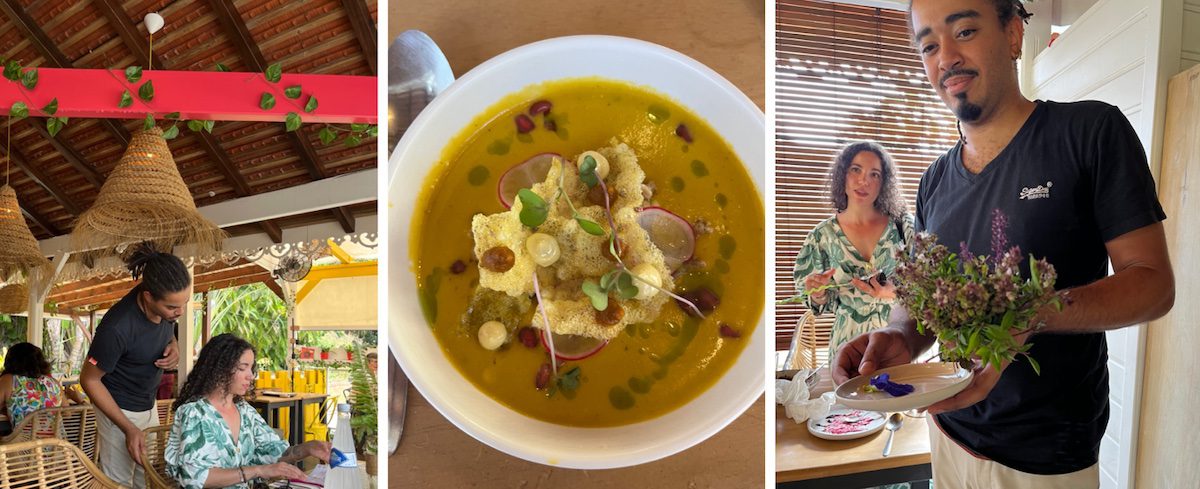
4. Explore Martinique’s hiking trails
The island boasts over two dozen incredible hikes and walks for all skill levels. Reconnoitre trails that lead to breathtaking viewpoints, cascading waterfalls, and hidden gems, all while contributing to conservation efforts that protect these natural habitats. Experienced hikers can tackle the 30-kilometre La Trace des Caps or the six-and-a-half-hour Pitons du Carbet, featuring dense vegetation and steep passages. For those seeking easier terrain, the Caravelle Peninsula offers scenic trails and a secluded spot for swimming, making it perfect for a more relaxed adventure.
5. Take a volcano tour in Martinique
Embark on an eco-tour to Mount Pelée, Martinique’s iconic volcano and a UNESCO World Heritage site. The volcano, along with its lush rainforests and the dense area surrounding the northern lava pitons, has been recognized for its outstanding natural value. On this tour, you’ll delve into the island’s volcanic history and discover the ongoing efforts to preserve this unique environment.
These guided tours provide a captivating insight into the natural forces that have shaped Martinique, highlighting the island’s commitment to sustainable tourism practices. Along the way, you’ll encounter diverse plants and flowers, learn about local conservation initiatives, and experience breathtaking views of Mount Pelée.
6. Discover Martinique’s cultural riches
Martinique’s history is as rich as it is complex, shaped by centuries of colonization and resilience. To truly grasp the island’s past, visiting La Savane des Esclaves is essential. Founded by Martinican historian Gilbert Larose (a wonderful and approachable local celebrity!), this outdoor museum is the culmination of his life’s work, dedicated to preserving and illustrating the island’s history over the last 400 years. Through meticulously recreated scenes and detailed exhibits, Larose vividly portrays life on the island before, during, and after the era of slavery.
The gardens are spectacular in design, and even more incredible is their educational value. Larose continues to cultivate dozens of medicinal plants that he still relies on today thanks to the teaching of his grandmother — one of the many ways he ensures that future generations remember the knowledge, struggles, and traditions of Martinique. I spent two hours at La Savane des Esclaves but could have stayed twice as long reading all the incredible information on the signs, watching Larose’s video, visiting the beautiful boutique and enjoying the delicious homemade ice cream.

Built by Gilbert Larose, La Savane des Esclaves features reconstructed Indigenous and Creole villages that illustrate what life was like on the island during the slavery era / Photos by Jennifer Reynolds
Further immerse yourself in Martinique’s rich cultural heritage by visiting historical landmarks in Fort-de-France. My favourites:
- Fort Saint Louis: A 17th-century fortress perched on the edge of the harbour, offering stunning 360-degree views of the city and the sea, along with a glimpse into the island’s colonial past.
- The Schoelcher Library: An architectural gem named after the abolitionist Victor Schoelcher, this library is as much a cultural monument as it is a repository of knowledge, with its ornate design and rich collection of books.
- The Cathedral of Fort-de-France: An impressive neo-Gothic structure that stands as a symbol of resilience, having been rebuilt multiple times due to natural disasters, and now offering a peaceful sanctuary in the heart of the bustling city.
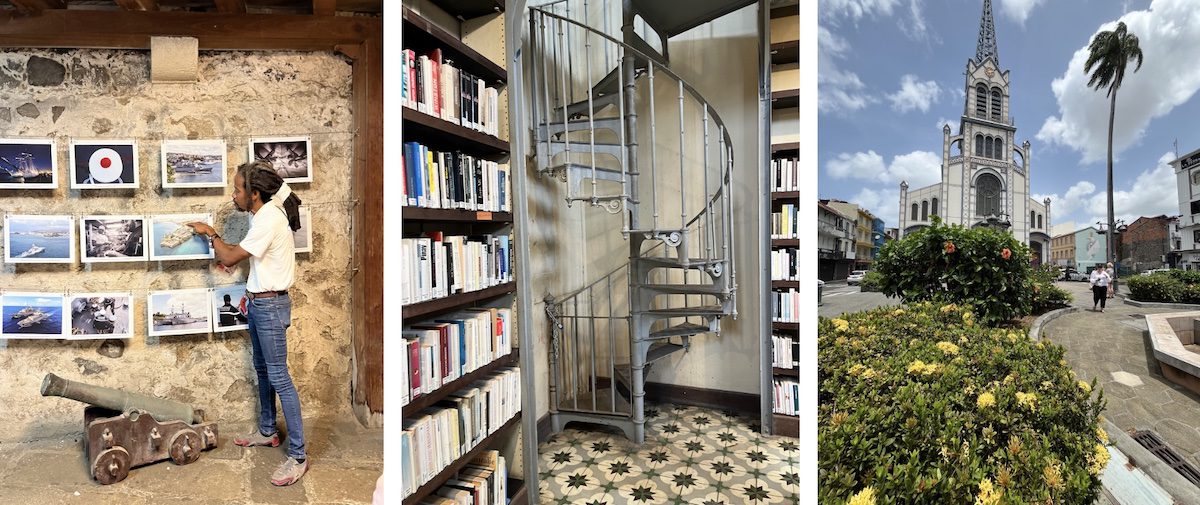
7. Immerse Yourself in Martinique’s History
Sip a little (or a lot of) rum. Exploring the rum distilleries in Martinique is more than just a tasting tour, it’s a journey into the island’s rich history and vibrant culture. Known as the “Rum Capital of the World,” Martinique boasts a proud tradition of rum production that dates back over three centuries. The island’s distilleries, many of which are nestled amidst lush sugarcane fields, offer visitors a firsthand look at the meticulous process of creating rhum agricole, a distinctive style of rum made directly from fresh sugarcane juice (the smell is amazing!) rather than molasses.
Each distillery has its own story to tell, with some, like Habitation Clément, set in grand colonial estates where you can explore aging cellars filled with oak barrels alongside sculpture gardens where contemporary art meets the island’s lush landscape. You can spend a couple of hours just strolling through the grounds to discover striking pieces by renowned artists like Jean-Michel Othoniel, whose glass bead sculptures create a captivating contrast against the tropical greenery.
Of the dozen rum distilleries in Martinique, Braud & Quennesson is the island’s newest and southernmost rhumerie. While the palm-tree-lined allée that leads to Maison Braud & Quennesson and the breathtaking views of the surrounding farmland are impressive, my favourite part of the experience was tasting the rum alongside the talented young cellar master, Stéphanie Dufour. Originally from Tours, France, Stéphanie has won several awards and gained international recognition for her (her!!) exceptional skills. It’s still quite rare to find women in leadership positions in the rum industry, and you can learn more about the women paving the way here.
Find tickets to rum distillery tours here!
Note: Rhum or Rum? The key distinction between Rum and Rhum Agricole lies in their base ingredients. Rum is typically produced from molasses, a byproduct of sugar refining, whereas Rhum Agricole is crafted directly from freshly pressed sugarcane juice.
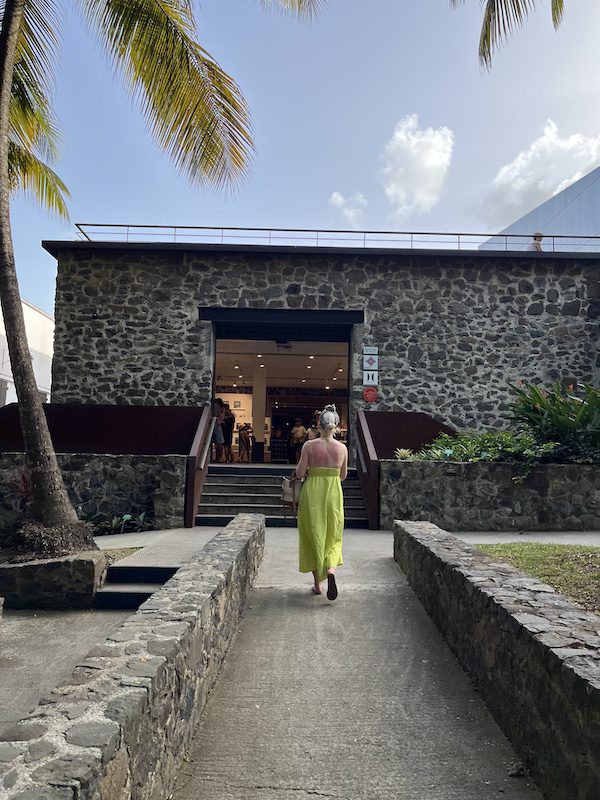
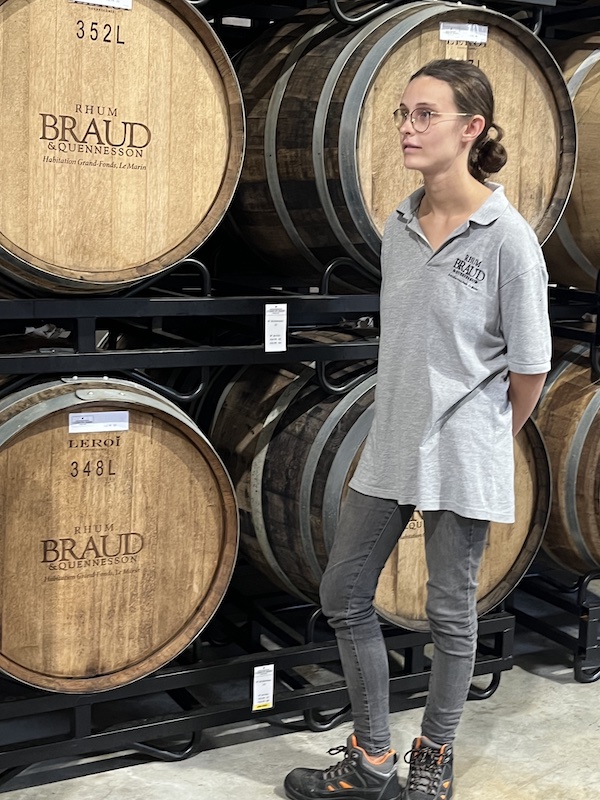
Martinique’s newest rhumerie, led by cellar master, Stéphanie Dufour, blends modern and old-world charm / Photo by Jennifer Reynolds
8. Celebrate Martinique’s local artisans and craftsmanship
A visit to the Village de la Poterie in Trois Ilets is a must for anyone looking to immerse themselves in Martinique’s vibrant artisan culture. Nestled within a historic pottery village, this charming enclave houses various workshops and boutiques where local artisans showcase their craftsmanship. From ceramics and pottery to handwoven textiles and unique jewellery, the Village de la Poterie offers handmade treasures that reflect the island’s rich cultural heritage. Walking through the village, you can watch artisans at work, gaining insight into their creative processes and the traditional techniques that have been passed down through generations. Supporting these artisans by signing up for a workshop or taking home a piece of their art as a souvenir.
9. Shop for Souvenirs Martinique
When it comes to bringing a piece of Martinique home with you, start with the island’s renowned spices, especially the four-spice mix known as “quatre-épices,” which includes a blend of nutmeg, cinnamon, ginger, and cloves. Shopping for these at the covered market in Fort-de-France is lots of fun, and you can always pick up more at Le Monde des Épices near the airport. Save room in your suitcase for your favourite rum, some locally grown coffee and artisanal chocolate.
Of course, Martinique’s artisan crafts make beautiful souvenirs too, if you have a place to pack pottery and woven baskets. Additionally, treat yourself to handmade soaps and custom perfumes, and since Martinique is a part of France, remember that you have access to a wide selection of French beauty products at local pharmacies.

10. Practice Your French in Martinique
While in Martinique, I was deeply moved by the warmth and kindness of the locals I encountered. From the moment I arrived, I was welcomed with open arms, and it quickly became clear that the island’s true treasure lies in its people. Their genuine hospitality and patience made me feel at ease, even as I reacquainted myself with speaking French. It was a joy to communicate through a blend of French, English, and the universal language of smiles, finding common ground in shared experiences and simple exchanges.
What struck me most was the deep connection the people of Martinique have with their land and heritage. Everywhere I went, I saw gardens bursting with fruits, vegetables, and herbs — plants that not only nourish the body but also carry the wisdom of generations. These gardens are a testament to a way of life that honours the past while nurturing the future, a tradition passed down through families with care and pride. It was an honour to learn from the people of Martinique, to hear their stories, and to be part of a community that understands the importance of preserving their culture and sharing it with the world. In these uncertain times, their wisdom feels more vital than ever, offering lessons in resilience, respect for the earth, and the power of human connection.
Disclaimer: Jennifer Reynolds was a guest of Martinique Tourism on a five-day media trip to the island in April 2024. This article was not reviewed by the tourism board prior to publication.
More From the Caribbean to Inspire You
JourneyWoman Webinar: Less-Travelled Caribbean & Mexico on September 24
Join our September 24 webinar to learn about the Caribbean and Mexico from experts in our JourneyWoman Women’s Travel Directory.
Discovering French Martinique: The Caribbean’s Best-Kept Secret for Solo Women
In Martinique, tropical landscapes meet adventure on the ‘Land of Flowers’, making it more than just the typical Caribbean getaway.
How to Have a Five-Star Beach Vacation in Antigua on a Two-Star Budget
Featured image: Diana shares her tips on how to travel on a budget in Antigua | Photo by SeanPavone on EnvatoCaribbean Bliss in Antigua for Under $3000 a week by Diana Eden My friend Ruth and I have promised each other that, no matter what other travels we plan for...

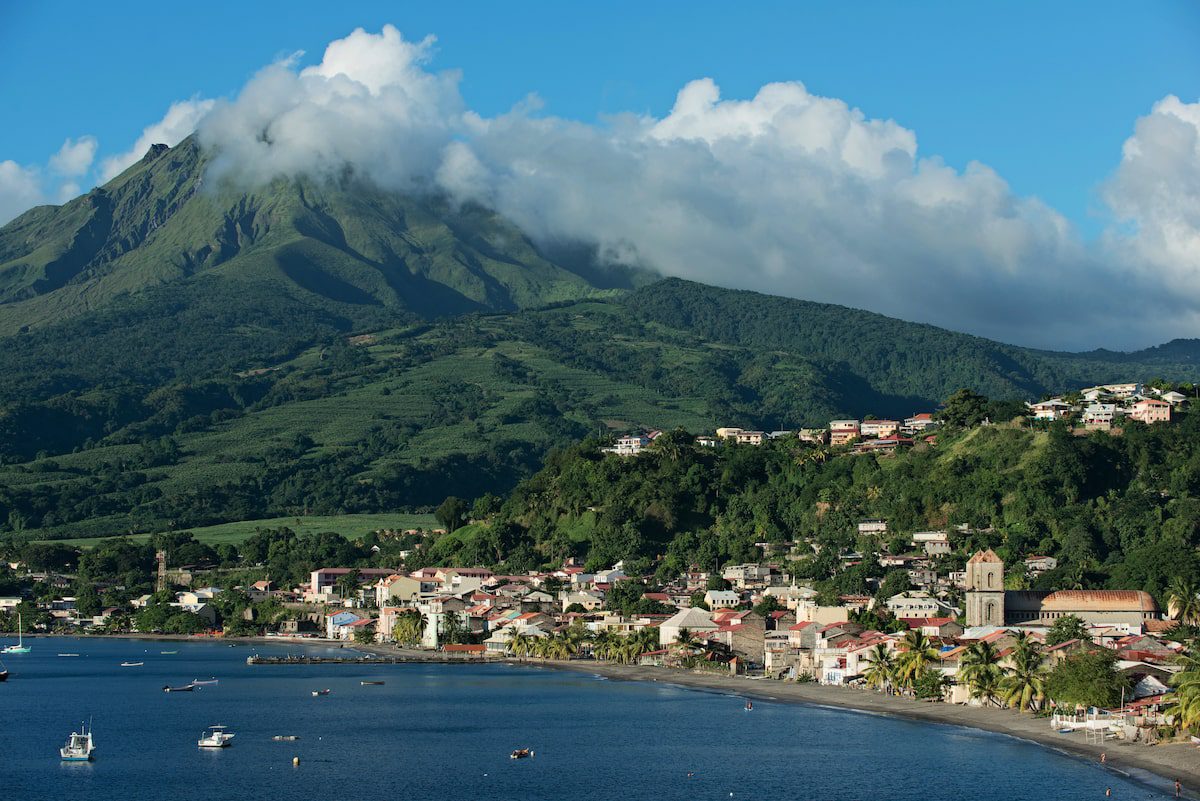


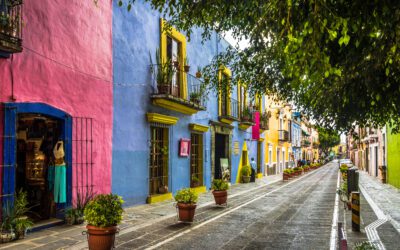


0 Comments
We always strive to use real photos from our own adventures, provided by the guest writer or from our personal travels. However, in some cases, due to photo quality, we must use stock photography. If you have any questions about the photography please let us know.
Disclaimer: We are so happy that you are checking out this page right now! We only recommend things that are suggested by our community, or through our own experience, that we believe will be helpful and practical for you. Some of our pages contain links, which means we’re part of an affiliate program for the product being mentioned. Should you decide to purchase a product using a link from on our site, JourneyWoman may earn a small commission from the retailer, which helps us maintain our beautiful website. JourneyWoman is an Amazon Associate and earns from qualifying purchases. Thank you!
We want to hear what you think about this article, and we welcome any updates or changes to improve it. You can comment below, or send an email to us at [email protected].